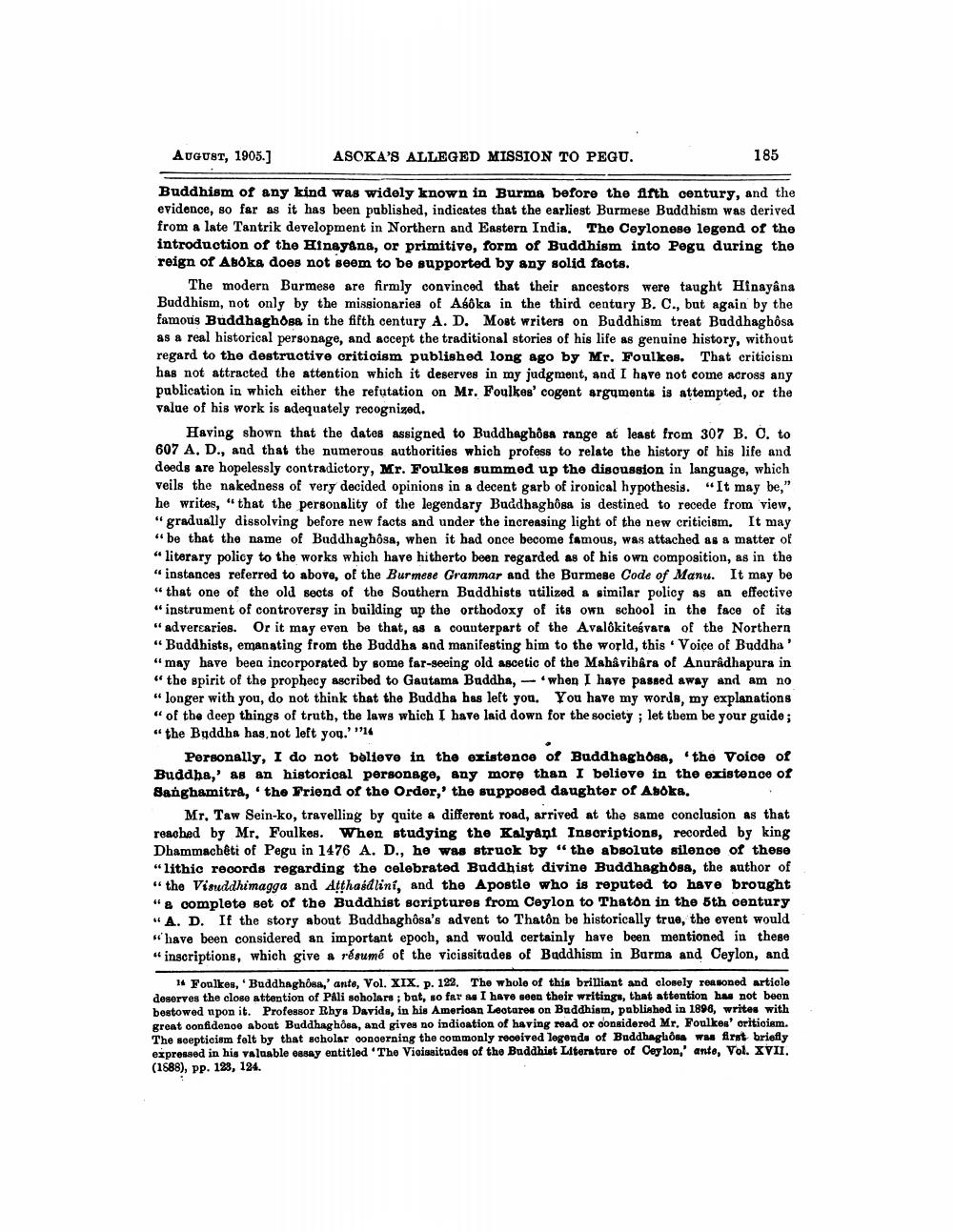________________
AUGUST, 1905.]
ASOKA'S ALLEGED MISSION TO PEGU.
185
Buddhism of any kind was widely known in Burma before the Arth century, and the evidence, so far as it has been published, indicates that the earliest Burmese Buddhism was derived from a late Tantrik development in Northern and Eastern India. The Ceylonese legend of the introduction of the Hinayana, or primitive, form of Buddhism into Pegu during the reign of Aboka does not seem to be supported by any solid faots.
The modern Burmese are firmly convinced that their ancestors were taught Hinayana Buddhism, not only by the missionaries of Asoka in the third century B. C., but again by the famous Buddhaghose in the fifth century A. D. Most writers on Buddhism treat Buddhaghosa as a real historical personage, and accept the traditional stories of his life as genuine history, without regard to the destructive criticism published long ago by Mr. Foulkes. That criticism has not attracted the attention which it deserves in my judgment, and I have not come across any publication in which either the refutation on Mr. Foulkes' cogent arguments is attempted, or the value of his work is adequately recognized.
Having shown that the dates assigned to Buddhaghoba range at least from 307 B. O. to 607 A, D., and that the numerous authorities which profess to relate the history of his life and deeds are hopelessly contradictory, Mr. Foulkes summed up the disoussion in language, which veils the nakedness of very decided opinions in a decent garb of ironical hypothesis. "It may be," he writes, "that the personality of the legendary Buddhaghôga is destined to recede from view, “gradually dissolving before new facts and under the increasing light of the new criticism. It may "be that the name of Buddhaghosa, when it had once become famous, was attached as a matter of " literary policy to the works which have hitherto been regarded as of his own composition, as in the "instances referred to above, of the Burmese Grammar and the Burmese Code of Manu. It may be " that one of the old sects of the Southern Buddhists utilized a similar policy as an effective "instrument of controversy in building up the orthodoxy of its own school in the face of its "adversaries. Or it may even be that, as & counterpart of the Avalokitesvara of the Northern “Buddhists, emanating from the Buddha and manifesting him to the world, this Voice of Buddha' "may have beea incorporated by some far-seeing old ascetic of the Mahâvihêra of Anuradhapura in “the spirit of the prophecy ascribed to Gautama Buddha, when I have passed away and am no "longer with you, do not think that the Buddha has left you. You have my words, my explanations " of the deep things of truth, the laws which I have laid down for the society ; let them be your guide; “the Buddha has, not left you.'"14
Personally, I do not believe in the existence of Buddhaghosa, the Voice of Buddha,' as an historical personage, any more than I believe in the existence of Sanghamitra, the Friend of the Order,' the supposed daughter of Asoka.
Mr, Taw Sein-ko, travelling by quite a different road, arrived at the same conclusion as that reached by Mr, Foulkes. When studying the Kalyani Inscriptions, recorded by king Dhammachêti of Pegu in 1476 A. D., he was struck by “the absolute silence of these "lithic records regarding the celebrated Buddhist divine Buddhaghosa, the author of "the Visuddhimagga and Atthaedliní, and the Apostle who is reputed to have brought "& complete set of the Buddhist scriptures from Ceylon to Thaton in the 5th century "A. D. If the story about Buddhaghôsa's advent to Thatôn be historically true, the event would " have been considered an important epoch, and would certainly have been mentioned in these “ inscriptions, which give a résumé of the vicissitudes of Buddhism in Burma and Ceylon, and
14 Foulkes, Buddhaghon,' anto, Vol. XIX. p. 122. The whole of this brilliant and closely reasoned artiole deserves the close attention of PAli scholars; bat, so far as I have seen their writings, that attention has not been bestowed upon it. Professor Rhys Davids, in his American Leotares on Buddhism, published in 1896, writes with great confidenoo about Buddhaghoa, and gives no indioation of having read or considered Mr. Foulkes' oritioiam. The soepticism felt by that scholar concerning the commonly received legenda of Buddhagloss was first briefly expressed in his valuable essay entitled 'The Vicissitudes of the Buddhist Literature of Ceylon,' anto, Vol. XVII. (1888), pp. 123, 124.




